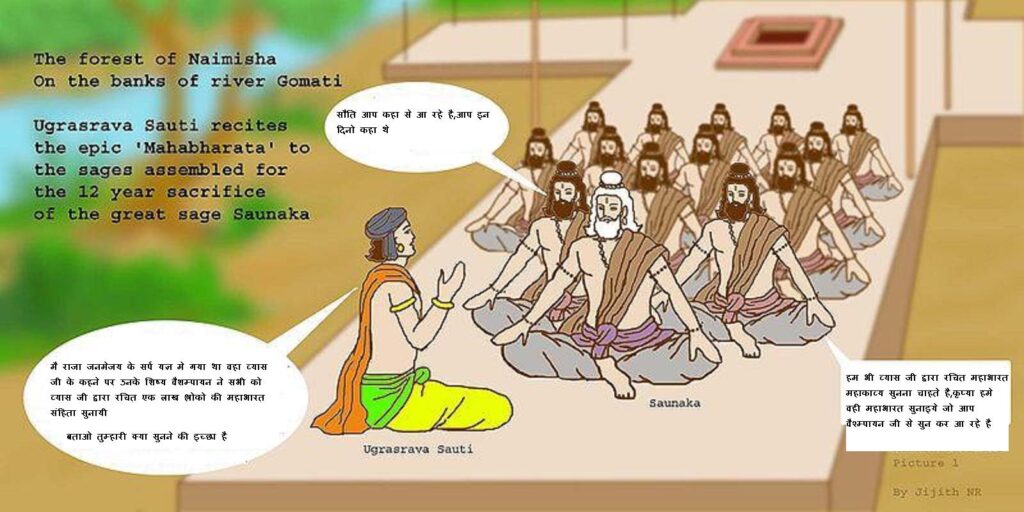Ugrasrava Sauti Goes to Naimisha Forest

Om! We utter the word Jaya only after bowing down to Narayana, Nara (the most exalted human), and the Goddess Saraswati.
Author’s Note: In the Unabridged Mahabharata, the entire epic is narrated by Ugrasrava Sauti (a bard) to the ascetics assembled in Naimisha forest in the hermitage of Rishi Saunak Kulapati. The epic begins with Ugrasrava Sauti approaching the ascetics and engaging in a conversation with them. While conversing, the ascetics ask Sauti to narrate the story of Bharata and the great war that took place at Kurukshetra. That’s how Ugrasrava Sauti begins narrating the epic.
A few more points:
- In the following paragraphs, the words ascetics, sages, and rishis are used interchangeably.
- Janamejaya was the son of King Parikshit and the grandson of Uttara and Abhimanyu. He is often referred to as a royal sage in the Mahabharata.
- Dwija means twice-born. The first birth is the physical birth and the second birth is spiritual.
- Dwaipayana-Vyasa is Rishi Ved Vyasa, the composer of the Mahabharata.
One day Ugrasrava Sauti, son of Lomaharshana, and well-versed in the Puranas, humbly approached the great sages who had participated in Saunak Kulapati’s twelve-year sacrifice in the Naimisha forest. The ascetics, keen to listen to Sauti’s marvelous stories, began to call out to Sauti as they saw him approach. Sauti was welcomed with due respect by the sages. Soon, he folded his palms and inquired about the progress of their asceticism. The ascetics offered a seat to Sauti, and after he was rested, one of the rishis asked him where he was coming from and how he had been spending his time. The ascetic wished to know everything in detail.

Note: More details about Naimisha Forest and its importance.
Sauti was well-accomplished in speech. He gave a detailed answer to the assembled sages using words and phrases that were appropriate to their way of life.
Sauti said, “I was at the snake sacrifice conducted by the royal sage Janamejaya. After the sacrifice, I wandered around visiting many sacred water bodies (lakes, rivers, etc) and holy shrines. Then I visited a place called Samantapanchaka. This place, venerated by the Dwijas, was also the site where the battle between the sons of Kuru and Pandu was fought. All the kings of the earth fought in that battle for either of the two sides.
Keen to meet you, I came here from Samantapanchaka. O sages, all of you are like the great God Brahma to me. O greatly blessed ones, you shine in this place of sacrifice like the solar fire. You have completed the silent meditations and fed the holy fire. And now you sit here without a care in the world. O Dwijas, which stories would you like to hear? Should I tell you stories from the Puranas that contain wise words about religious duty and worldly profit? Or should I narrate to you the actions of illustrious saints and great kings?”
The rishi, who had initially addressed Sauti, answered, “The Purana first composed by the great rishi Dwaipayana-Vyasa is the most eminent narrative that exists. This Purana is highly esteemed by the Gods and Brahmarishis. Its passages have been obtained from the Vedas and possess subtle meaning in a logically combined manner. It includes subjects from several books and is presented in elegant prose. This Purana contains the essence of the four Vedas and its subtlety is clarified by other texts.”
The rishi continued, “We would like to hear that Purana. That history called Bharata composed by the wonderful sage Dwaipayana-Vyasa. That text which is known to dispel evil. We would like to hear it just as it was recited by rishi Vaishampaya at the snake sacrifice of Janamejaya.”
Having heard the rishi, Sauti said, “I bow down to the primordial being Isana who is adored by everyone. Isana is the true incorruptible one: the Brahma, perceptible, imperceptible, and eternal. Isana is both a non-existing and an existing-non-existing being. Isana is the universe and also distinct from the existing and non-existing universe. Isana is the creator of high and low. Isana is ancient, exalted, and inexhaustible. Isana is Vishnu, beneficent and beneficence itself; pure and immaculate. Isana is Hari, the ruler of all faculties and guide of all things moveable and immovable.”
Sauti continued, “I will now recite the sacred thoughts of the great rishi Vyasa, of marvelous deeds, and worshipped by everyone in this assembly. Some bards have already recited this history, some are reciting it now, and yet others will propagate it in the future. This Purana is a great source of knowledge established throughout the three regions of the world. The Dwijas know of this Purana both in its detailed and concise forms. It is a delight of the learned because it is decorated with elegant expressions, human and divine conversations, and many poetic measures.”
Previous: Introduction
Next: Creation Story of the Universe as Explained in the Adi Parva
